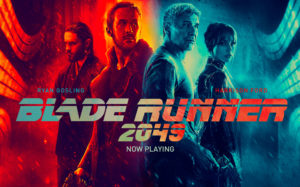
 (4 / 5)
(4 / 5)
The images and themes of Blade Runner are some of the most iconic in movie and even pop-culture history. They have influences and been ripped off so many times and yet there’s still nothing quite like the original. Whether a sequel was necessary or wanted is now irrelevant, it’s here and the story now continues.
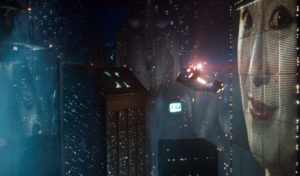
I have to confess that I’ve never been a fan of the original movie. I ‘ve seen it three times, I like hearing analysis of it and talking about it and it is undeniably influential and amazing to look at, but frankly actually sitting down and seeing the movie play-out has never given me a thrill.
We get a black screen where writing comes up informing us of the essential information we need to know going into the movie. Replicants are synthetically grown humans that developed their own humanity, they rebelled but a new company has emerged which makes Replicants that obey absolutely, the old models are still running around Earth so there are still agents that hunt them, which are still called Blade Runners. The first shot, as the original, is with the opening of an eye. Who eye? It does not matter. We then see a flying car hover above a grey landscape, where eventually there’s some kind of farming land. The car lands and a man gets out, he enters the house and waits for it’s owner (Dave Bautista), through a series of questions it’s obvious that he is a Blade Runner here to “retire” this runaway Replicant.
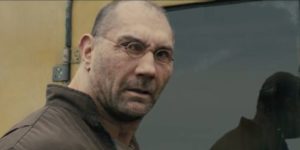
The Replicant fights back, slamming him through a wall but he is stronger than him. Yes this Blade Runner is a Replicant. The Replicants name is K (Ryan Gosling). Before he heads back he finds a buried box under a dead tree and number carved into them that have meaning for K.
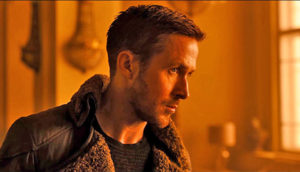
Being that he’s not human most of his emotions are subdued, for a large portion of the movie Gosling is rather stone-faced throughout it. That’s fine because there are other more expressive characters that keep the energy alive, his real effort goes into his body movement, being sleek and efficient. However you can still see the glimmers of the thoughts that are going on under the surface that come out in little eye movements or furrowing of his brow. Plus there is a scene in which he comes to a realisation about himself and without going over the top delivers an amazing reaction. For this, I believe it is one of his best performances.
Something I applaud this movie for is it’s very little amount of action. There are hand-to-hand sequences and a shootout scene or two but this movie really relies on creating images, atmosphere and provoking deeper questions. Science Fiction isn’t supposed to simply entertain you with things going bang and flashing lights, its meant to give you ideas.
Blade Runner has never been a typical science fiction movie. It was more like an existential Film Noir set in the future. It had a lonely man wandering the streets of a dark city and asked questions about what makes us human. This is still that movie.
In the directors chair is not Ridley Scott but Denis Villeneuve. He made Arrival last year which really impressed me so I had no objections to him taking the realms on another science fiction movie. He has clearly done his research for what this world is like. He and cinematographer Roger Daekins have created the same dark, rainy world lit with headlights and advertisements, as well as a few other images that will most likely become classic. Whats striking is the way many scenes are composed with the minimal amount of detail and only a few shapes to help fill in what they are. Take a shot where its mostly black but a few coloured lights help us register that there is a car behind the character.
Someone else that’s taking over is Hans Zimmer and Benjamine Wallfisch on the music where it was previously handled by Vangelis. They have a frame to work within and I believe to sounds like the original. For the big city shots it’s your traditional piece you would expect to hear but there are other moments where the characters dwell on other things and it becomes a deep meditation. They use electronic instruments but create an organic sound with them.
https://youtu.be/m_PWSGy2jDc
I have no idea how well this movie will be received by the public or by other critics. I also cannot guess how successful it will do at the box-office or with the fans of the original. But I do admire the visuals and the technical achievements put into this movie. I remember some of the shots very clearly and the feeling of the atmosphere it created. It shows a world far off in the future where technology is capable of so many things but the greatest question man faces is within themselves.
Category Archives: Film & TV
Review The Rise and Fall Of Little Voice, Theatr Clwyd by Karis Clarke
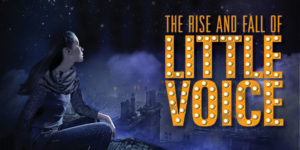
 (4 / 5)
(4 / 5)
As a critic I am not technically minded, I view a play and my mind will automatically focus on the acting ability of the cast , as my background is in performing. However it would be impossible not to be blown away by the genius set design and the technicality of this production.

Using a revolving room on a split level, and a dividing floor the design by Amy Jane Cook easily managed to give the illusion of an open dolls house. (If the dolls house was a northern council house with poor electrics and bad house keeping!) This enabled the lounge, kitchen diner and bedroom all to be in full view of the audience. With swift transitions the bedroom revolved, the living room divided and the set transformed to Mr Boo’s night club. The first transition took place just after the beginning of the second half and was met with suitable gasps of awe from the impressed full house.

It would be rude not to give credit to the lighting design, by Nicholas Holdridge although naturalistic in nature a majority of the play took place in dimly lit rooms and at one point darkness. However the clever use of street, moon, dawn and torch light ensured the actors were always well lit and the tone and atmosphere were heightened. This combination of stage and technical magic combine in the final stages of the production, not wanting to spoil the effect -Theatre Clwyd’s production does stay true to the film and they do so very effectively. A combination of smoke, lights movement and LV’s impressions as she reaches breaking point culminates to an intense stage experience.

The cast were as impressive as the set, comic timing, physicality and delivery were strong. Each member of the small ensemble allowed each other to have stand out moments as well as ensuring they all worked well together to perform some very funny dialogue, comedic banter and duets. (watch out for Nicola Reynolds, Mari Hoff, LV’s mum and the brilliant Victoria John, Sadie, the down beaten neighbour performing “It’s Raining Men”)

This play can only work if LV can actually deliver the impressions stated – ergo this play works. It has been stated on social media that when Catrin Aaron sings its like Judy Garland is in the room. I fully agree – except Shirley Bassey, Marilyn Monroe and a host of others are there with her.

I was slightly disappointed with some of the direction of the play, continuity of stage exits occasionally seemed haphazard – this could be due to them being sacrificed for the technicality of the production – in which case I can forgive the occasions when walls are walked through – however towards the end of the play it felt like the cast had forgotten where doors were and they were just walking wherever!
Jim Cartwright’s script is undoubtedly witty and gritty and is supposed to be full of hilarity and vulgarity, however, I was waiting for the all important point when I would feel empathy with the characters, for me, it didn’t happen. I put this down to the direction of Wasserberg rather than the acting ability of the cast. It was played for laughs and in doing so the characters became more caricatures – that although I laughed with, I never fully connected with.
Other than this, it was a pleasure to watch, strong female leads and the standing ovation was justly deserved. Little Voice hits the right notes.
Theatre Clwyd, Antony Hopkins Theatre,Tuesday 10th October . Directed by Kate Wasserberg
Review The Mountain Between Us by Kevin Johnson

An interesting but flawed idea, two strangers survive a plane crash in the mountains, get to know each other as they try to walk out of the frozen wilderness, and begin to fall in love.
Idris Elba shows his star quality by holding his own against Kate Winslett. They have chemistry, and full marks for casting an interracial couple, but it doesn’t quite work.
Films like this drive me mad, because they’re so close to being brilliant, but fall short. The scenery, mostly snowy mountains, is amazing, the music is good, as is the direction, with some innovative touches. The script, however, lets everyone down.
Elba is an emotionally constipated neurosurgeon, Winslett a maverick photojournalist, both are strong-willed yet it’s she who drives them on while he wants to play it safe. So far, so good.
What could then have been developed into an interesting character piece, starts to unravel. Winslett keeps moaning about her poor fiancé, whilst the plight of the ten year old patient Elba was supposed to operate on is ignored.
It doesn’t help that the film is divided into ‘before and after’ section, which means the ending gets bogged down in romantic cliches that dilute the emotional momentum from before. There’s even a sex scene which, although beautifully filmed, jars with the story.
The film falls between two stools, neither a romance nor a survival thriller, although it tries to be both. Not a bad film though, just not a great one.
Oh and there’s a cute dog.
Review Night Is Short, Walk On Girl by Jonathan Evans

 (4 / 5)
(4 / 5)
This movie is greedy in it’s concept and gratuitous with it’s execution, however I don’t mean any of those as insults. It is greedy because it excessively wants to pack so much into the movie and it is gratuitous in the way that it gives more than is necessary. It wants to create as many images and scenarios as it can and have you feel as many emotions on the spectrum as you can.
The Night is Short, Walk On Girl opens on a marriage ceremony where two of the guest Senpai (Gen Hoshino) is smitten with a girl who he goes to college with who we will simply know as The Girl with Black Hair (Kana Hanazawa). He has strategically coordinated himself so that they constantly run into each-other so she will believe they are meant to be together. She is of age to drink and wants to earn her adulthood so she drinks at the celebration and then goes out for the night, he then peruses in an attempt to push the destiny idea.
From here on it is a case of The Girl with the Black Hair walking around in the nighttime and encountering people and their scenarios and getting involved with them. Meanwhile Senpai is in some way deterred by another story or in his efforts to aid her.
The drawing style of this movie is certainly not like typical Western animation of Disney but also not like other anime movies like Ghost in the Shell or the works of Hayao Miyazaki. The lines are thin and very little detail is used. Eyes are represented with a few lines and a coloured dot underneath. You can squint and still understand nearly everything onscreen because it is comprised of simple shapes and vivid colours.
This movie plays non-stop. When you watch it be prepared to read the subtitles fast and suck in the visual information onscreen. Luckily the image is so clear and accessible. If you have ever viewed FLCL then you will have an understanding of this movies sprinting pace.
This movie is a comedy if nothing else and has an extremely simple plot which allows the creators to put in as many different character, plot points and setups as it can. From a chase, to a drinking contest, to a few musical numbers, all are displayed with as many transitions emotions and levels or ridiculousness that it possibly can. It cooks up a wide buffet of animation and movies and allows you to be stuffed and very happy by the end.
Review Victoria & Abdul by Jonathan Evans

The opening text of Victoria & Abdul goes “Based on real events…mostly.” That insertion of the last part eases the audience that though the idea and some events may have accrued, they are taking liberties. It allows us to take some of the more eccentric moments and inaccuracy’s with a pinch of salt and enjoy the moments.
We open in India where a simple man names Abdul goes about his simple duties. By chance he is selected to present Queen Victoria with a gift, simply because he is tall. So he gets shipped off to England and when the pivotal moments comes he is instructed to not to make eye contact with her majesty. Guess what happens!
Dench is actually returning to the role of Victoria. She originally played the monarch in Mrs. Brown, where oddly, was also about the Queen befriending a servant. There’s not much to write about the performance I feel, Dench has proven her chops as an actor again and again. Here she handles the part of one of the longest running monarch’s as a woman that is more than used to getting her way, but also fatigued with the repetition of ceremonies and political news. It is when this young Indian servant enters her life that she becomes reinvigorated with someone that speaks to her like an equal and has a different view of the world.
Abdul played by Ali Fazal will most likely bring a smile to your face. He himself is so smiley and optimistic but not without a sense of being grounded. He can be sad and worried, but that is understood because he has his faith that reassures him of a positive outcome. If it were not for these moments then he would most likely become grading, but with these touches he is enduring.
Typically in these kinds of movies with big named stars and based on historical events you can bet that the studio and filmmakers are seeking an Oscar for their efforts. It may well win or at least be nominated for cinematography and/or costume design. But the moments that will most likely receive a nomination, even a win. This is a moment where Dench is framed in closeup and it never cuts away and she delivers a summary of this entire woman’s life and role. This, on one hand, it obviously trying hard to win the Oscar, but also on the other it is a sharply executed performance that is very well written.
Eventually there come moments of unhappiness and sombreness. Such moments in movies come and go with varying degrees of effectiveness but these ones truly struck me. It works by starting with sugary charm and digging deeper and deeper into the characters and the way each of their worlds work as well as life as a whole we come to truly tender moments.
Historical accuracy interest me rather little, what engages me is characters and themes, the movie has these. It has charm and fun but by the end leaves you with a sense of understanding of the connections between people.
Review Mother! by Jonathan Evans
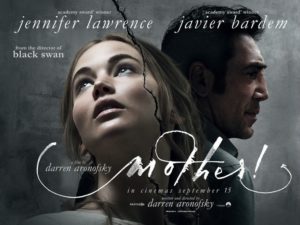
 (3 / 5)
(3 / 5)
Mother! Is a movie by a man that operates his own way. The setup is a man and a woman live in a little house together, they are married, there’s an age gap between them and there was a fire which ruined the house and she has spent the her time repairing it for the two of them. We never learn their names, nor anyone’s in the movie, the characters operate on the roles in the piece.
Jennifer Lawrence is put through the emotional ringer as someone that has to be naive, balancing frustration and then terrified of her situation and others.
The other cast members are here to serve as counterpoints to her character. Either intruding on her barriers or in no way being civil or polite. They all do this to varying degrees, some creep through bit by bit before they say or do something that is blatant, others arrive and are instantly crass and detestable.
The house itself is made almost entirely of fresh wood, a spiralling staircase take it’s inhabitants up and down and has designs on the windows, floor and ceiling that probably don’t serve any other purpose than to engrave themselves on the viewers mind. It sits in the middle of a green field that is surrounded by a seeming endless forest.
The wife and Him (Javier Bardem) are living their lives when suddenly there is a knocking at the door. It is a man (Ed Harris) that was wandering and just wants to say hello, he is invited in for a drink and then is also invited to spend the night. All at the behest of Him. Then eventually the mans wife (Michelle Pfeiffer) arrives at their door and is also staying at their house. As each new visitor seemingly just arrives Him is completely accepting of every new arrival and welcomes them into their home.
Aronofsky’s main reoccurring theme throughout his work is characters that seek divinity but ultimately fall short due to the world or their own shortcomings. Here Lawrence’s character wants to create the perfect, idyllic home for herself and the man she loves. However he is not content with simply her love, he needs it from others.
The movie is, I suppose a horror, it certainly has moments of fright, terror and unease. In the sound department it is certainly one. Every little spec of sound, from the footsteps, the insects outside and others that come later on that will most likely disturb are sharply captures and layered.
When we reach the climax of the movie it is like Children of Men within The Amityville Horror. It is a roaring, swirling, completely mad experience where all of humanities savagery is displayed before us and at times is horrific and at some bits, pretty funny. Like a cartoon. Aronofsky doesn’t believe in slow, delicate climaxes, he always goes all out and loud.
This is a slow movie that builds to a heavy handed finale of no subtlety. But at the same time you can see that this is the work of a great craftsman who also posses an original voice. Just the originality and way it plays-out is something worth seeing in a time of remakes and franchises. In terms of low scale horror it is not as finely tuned or effective as Get Out, as a larger vision it isn’t as rich as A Cure for Wellness but that’s also it’s appeal as a whole, it isn’t like anything else.
Review ‘Oz With Orchestra’ by Gemma Treharne-Foose

 (3 / 5)
(3 / 5)
I kicked myself for a few reasons last Sunday. The first of which, I came to discover, was not doing my research on major events in the city the same day I headed out to watch ‘Oz with Orchestra’. The event at St David’s Hall clashed with the Tour of Britain final meaning my plans for a leisurely jaunt down the A470 to enjoy some pre-show family entertainment were almost scuppered by a 1hr 50m traffic jam. We certainly weren’t in Kansas anymore.
Once I’d managed to make it through the rain and in to St David’s Hall, I was pretty much over the worst of my traffic jam rage. It was going to be fine, it was Wizard of Oz! Plus there were some jolly looking souls dressed up as Dorothy, Tin Man, Scarecrow and the Lion. My 8 year old was delighted to take part in a treasure hunt and there were other activities to keep kids entertained, though she deemed herself to be far too mature to enjoy a singalong with the WNO to the best hits from the movie. You can lead a horse to water but you can’t make them sing ‘over the rainbow’.

The other reason I kicked myself was because the event would have been a great opportunity to don some sprarkly shoes or a wee bit of festive cheek glitter. I suppose a 36 year old with a rainbow painted on her face would have been a step too far, though.
Seeing the volume of little kids and the size of the space, I wasn’t sure how well the film audio of ‘Wizard of Oz’ and a live 63 piece orchestra would work or if this could sustain the attention of very small children.
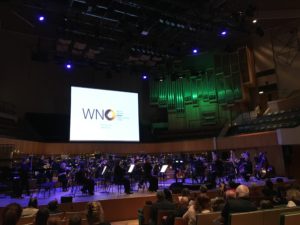
I’ve never seen any cinema classics accompanied by an orchestra but was amazed to see the orchestra pick up every cue, every dramatic effect with ease. Such was the level of intensity and emotional impact of this well-loved family classic, I was in tears in the opening bars (sucker!). The tornado scenes were simply stunning – deafening crescendos, buzzing bases and whistling brass and percussion created a beautiful musical backdrop for the cinematic mastery on screen.
This was such a lovely and fresh addition to this cinema classic and Grant Llewellyn’s direction helped ensure that there was a synergy between the musical soundtrack and the duologue on screen. The film and the music are so timeless, so sentimental and impossible to top and the orchestra was an ideal introduction for my little girl to enjoy this kid of musical performance.

I thought the WNO and venue did well to engage with families at this event and I’d take my little girl to see WNO again in a heartbeat.
IT Review
“I recognize terror as the finest emotion and so I will try to terrorize the reader. But if I find that I cannot terrify, I will try to horrify, and if I find that I cannot horrify I’ll go for gross-out. I’m not proud.”
-Stephen King
 (3 / 5)
(3 / 5)
Stephen King is author that has one of the most loyal and enthusiastic followings of nearly any writer in history. His fans obsess and devour his books, so no wonder why he is also regularly adapted to the screen. There are many shoddy productions of Stephen King material. This is well produced at the least. You can tell that from the clear images and the visuals and detailed production value. But does it succeed in and kind of engaging horror?
IT tells the story of a small town called Derry in the eighties where it seems Norman Rockwell’esque, however people are going missing, mostly children. Only a handful of children are catching onto the pattern that there always seen the same demented clown appears and they unite in solving the mystery.
The children are Bill (Jaeden Lieberher) who has a stutter and is very determined to solve the mystery because a year ago he lost his brother Georgie to the clown. Ben (Jeremy Ray Taylor) is the new kid in school as well as being overweight so he spends time in the library. Richie (Finn Wolfhard) is the wisecracking comedy relief who’s jokes don’t always land but he keeps trying. Eddie (Jack Dylan Grazer) is the timid, germaphobe who is the one to suggest that they don’t go into the scary places. Mike (Chosen Jacobs) the only black youth in the whole town and has suffered hardships of being an outsider. Stan (Wyatt Oleff) who is the most logical one, believing in facts and rational and second guesses all the supernatural elements. Finally there is Bev played by Sophia Lillis, who is by far the best talent in the movie. She is able to encapsulate all the fear, confidence and insecurities within this one character. I hope to see her go onto more things.
Until now our only personification of Pennywise the clown was Tim Curry in the miniseries. That was a fun performance but only in the sense that it was an actor going all out with not restrictions. Watching it now as a fully grown adult, you’ll probably be entertained but doubtful be scared. Now Bill Skarsgard is under the makeup, he also goes all out in his performance, however there are delicate touches of control here, adding glimpses of his sinister intentions through bouncy clowning. Also aiding in the overall terror of his performance are some genuinely creepy ideas of what to do with him (none I shall spoil). Finally he comes with much more convincing special effects this time around.
King is a writer who has developed many reoccurring cliches within his work (IT has more than a few). But the one I want to focus on is the way too mean and soulless portrayal of bullies. The bully here is a boy names Henry (Nicholas Hamilton), a complete psychopath that must be a bully, it is his desperate role in life. This is over-the-top and quite frankly unbelievable,
Just like in A Cure for Wellness, Benjamine Walfisch delivers a melodic score that starts as whimsical childhood and then drifts into demented screams. Much like Bernard Herman in Psycho for the main moments of fright he cuts out all other instruments and just uses the strings, creating high-pitched shrieks.
As of this point of writing this review I have never read a Stephen King novel. However from what I understand of his prose they have great ideas and are engaging page turners. However they also are very wild and don’t lend themselves to being put to screen because of an idea that would work while reading it might not be so brilliant when is actually visualised. As for what the book is like I do not know, but they seem to have run with the idea and added and changed elements to make them better suited for the medium.
Whilst there are moments of genuine frightening material in here there are other moments when it goes too far and it’s just the movie yelling at you. Though for the moments of the children being children and the moments of fright they are very much worth it.
Review The Dark Tower by Jonathan Evans
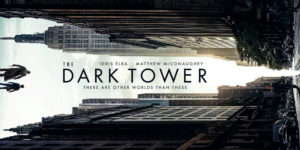
 (3 / 5)
(3 / 5)
There are many, many stories like The Dark Tower. A child that exists in the mundane world that we know and then stumbles into a world unlike our own where they must manoeuvre it as well as see many interesting things along the way. One of the first examples of this is Alice in Wonderland, then The Wizard of Oz and many more. But while concept is one thing what truly matters is execution.
Our lead is a boy named Jake Chambers (Tom Taylor), he is mostly a loner and has dark dreams of another world where monsters dwell and there is a large black tower that stands. He goes to therapy to talk about how he believes that the earthquakes that happen in the real world are related to what is happening in his dream. Of course the world is real and he eventually finds a way there. Taylor handles the role well, displaying all the panic, fear and confusion clearly and convincingly.
In the other world Idris Elba plays Roland who’s a Gunslinger, basically a knight that roams the land and rights wrongs. But he is the last of the Gunslingers and has become disillusioned with helping people. It is also established that he is a little stronger and faster that the average human, so he can heal faster, do more impressive feats and take more of a pounding and not die. I must give the movie credit for not being on tracks with the stereotypical stern mentor figure. There is a moment in the movie (I wont spoil it) where something traumatic happens to Jake, he says that they have to move but he speaks calmly to him and isn’t above giving him a hug.
The antagonist is a magician of some kind and mostly referred to as “The Man in Black.” He is essentially a very powerful being of pure evil. He is used to getting his way and can treat anyone how he wants. Mathew McConaughey is clearly having fun with the role, this is an excuse to be devilish and swaggering. As a characters there’s no real depth, but as a scary threat, he does the job.
Movies these days seem to be very franchise orientated. Wanting to adapt books is nothing new but now studios really want books that are part of a series, so that they can not just get one but many movies out of them. This probably stated with Harry Potter, kept on going with Hunger Games and is still common now. As of writing this I have never read the book by Stephen King that the movie is based one, but this is fine, audience members shouldn’t have to read the book in order to enjoy the movie, they should buy their ticket and enjoy it regardless. This movie is fine to understand, there are things that go unexplained but you don’t always need exposition for every single thing that happens in a world. I heard from one source that a movie could never do the source material justice because the books go so weird and high concept, well that may be, but as a movie it’s fine.
As stated earlier the concept is not original. The best examples of movies that use this concept would be The Wizard of Oz and Labyrinth. On the opposite scale, the weakest movie I’ve seen with this idea is Percy Jackson & The Olympians The Lightning Thief. This movie isn’t the pinnacle of this genre but it is also far superior to Percy.
When the movie ends the story that kicked everything off is wrapped up nicely as well as leaves itself open for other scenarios to happen. Being that there are many books in the series if the film is a success this will happen and if not then it will simply be as it is.
Review Atomic Blonde by Jonathan Evans

 (4 / 5)
(4 / 5)
There are many movies like Atomic Blonde. A sensitive, political situation where a top agent is called in to handle it and what follows is a chase, gunfights, hand-to-hand combat and some sharply worded moments over a bar. Many movies follow the same form, what matters is the effort and result. This decided new film from director David Leitch decided to use a more vibrant colour pallet and attempts to really make you feel the fights going on.
What is the plot? Who cares. Seriously though the movies premise is as simple as I previously described but in order to be professional I’ll elaborate. In 1989 the Berlin wall came down, the city was complicated in terms of it’s politics (to put it simply), spy’s are everywhere, one spy is taken down who has a list of the names of all the active spy’s, there is another man that wants to defect and has committed all the names to memory. So Lorraine Broughton is called in cause she’s the best at all secret agent skills. Honestly this doesn’t matter, the plot is a thin clothing line to take us from one set-piece and character after another.
Charlize Theron has established herself as one of our greatest living actors. Able to handle intense emotional material and be the grand star of a blockbuster. This is a role where she is the Fe-male equivalent of James Bond, stylish, a drinker and very dangerous. She is beautifully shot however the filmmakers don’t just make her a something beautiful, she is a fighter and they give her bruises and cuts.
In Berlin her contact is David Percival (James McAvoy), a British agent that has allowed the corruption and brutality of Berlin to envelop him. McAvoy can handle this kind of role with ease, he is the kind of actor that believes in giving it all or go home. He gives it all.
During the day Berlin is a city of black and white, but at night it comes alive with dark shadows and turquoises and fuchia. The colors are in-keeping with the time and feel of the movie, disco and dance.
The extra layer of style in the movie is the soundtrack. Banging dance tracks that add a spicy tone to the movie as well as make the feel rather tongue-in-cheek. This works, it allows you to get into the rhythmic nature of the movie and know that it’s about the style and experience.
https://youtu.be/8JeU0_1CTdA
Not every movie needs to stir your soul. Others don’t even have to be that original in terms of their premise, but they do need to properly convey their goal. Atomic Blonde seeks to entertain you showing a dank, sexy ride. It does this very well, you are seduced by the aesthetic and engaged by the visceral action.

